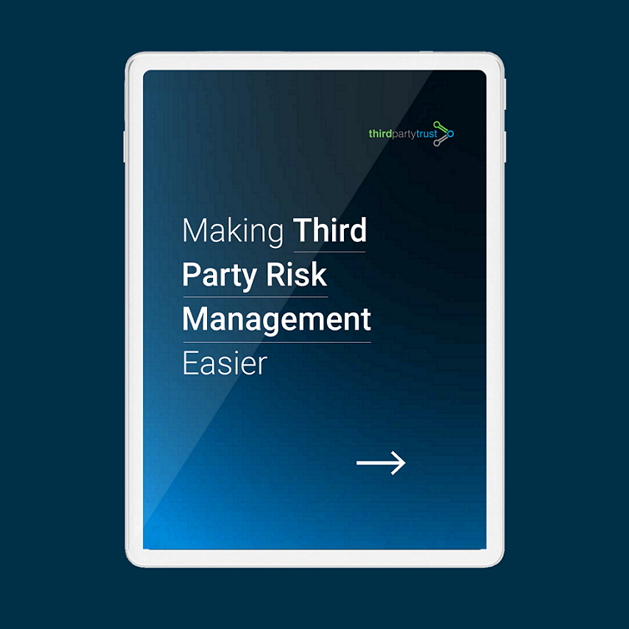TPRM and GRC: GRC Assessment Tools and Monitoring with TPRM
TPRM and GRC are interconnected parts of enterprise risk management, especially for organizations in regulated industries. The usual operational goals of accelerating processes, reducing cost, and optimizing resources increase the need for dedicated tools, so it’s fair to ask – do you need both TPRM and GRC tools?
Companies tend to think integrating all the risk processes under one system is the most efficient choice, but there’s more to it. Here are the main considerations you should factor into your decision.
What is the purpose of a TPRM tool?
Third party risk management (TPRM) is the process of identifying, analyzing and controlling risks presented to an organization by its third parties, including vendors, suppliers, contractors, customers, or regulators.
TPRM involves: Collecting critical information about third party vendors to assess their security posture; understanding what systems or information they have access to and the risk they pose to the organization; ensuring they comply with internal and external regulations; and monitoring any changes in their security procedures over time.
Download Free Guide: Building a Scalable TPRM Program
Therefore, a TPRM tool is one that facilitates the vendor risk assessment and provides functionality to continuously monitor their security posture. This includes a wide range of features like:
- Automating the intake process and the connection with third party vendors to ask them to complete requirements
- Building a vendor inventory and categorizing them by business impact, department they work with, criticality of service, regulations they need to comply with, etc.
- Customizing the assessment requirements based on the type/category of vendor
- Devising processes to focus on the most critical third party vendors
- Understanding and quantifying risk across the vendor population, including risk score, financial viability, privacy policy, data breach history, etc.
- Sending and receiving reminders for vendor security documentation that’s about to expire and needs to be updated
- Monitoring the vendor’s security performance to ensure their services are delivered per the terms of the contract and there are no emerging risk factors
What is the purpose of a GRC tool?
Governance, Risk, and Compliance (GRC) is a set of practices and processes that provides a structured approach to aligning IT with business goals. GRC helps companies effectively manage IT and security risks, reduce costs, meet compliance requirements, and improve decision-making through an integrated view of how well they manage their risks. These encompass operational risk, policy and compliance, IT governance, and internal auditing.
GRC tools translate regulatory requirements from all kinds into action items, ensuring the company is meeting internal compliance and risk standards. This encompasses risks associated with the use, ownership, or adoption of IT within a company. Therefore, risk – and more specifically, vendor risk – is just one of the many areas that they manage.
Most GRC tools include features like:
- Workflow management to implement and monitor GRC-related processes
- Document management to create, track, and store digitized content
- Risk data management and analytics to measure, quantify, and address risk
- A dashboard with KPIs relevant to business goals that can be monitored in real-time
- Audit management to organize data and simplify the process for conducting internal audits
Why interchanging TPRM and GRC tools is not a good idea
Effective GRC tools are used to create and distribute policies and controls that can be mapped to regulations and compliance requirements. They help assess whether controls have been deployed, are functioning correctly, and are improving risk assessment and mitigation.
This may sound similar to the core functions of vendor risk assessment and TPRM, which often leads organizations to use GRC tools to execute their TPRM program. But GRC tools are too heavy, non-focused, and siloed to be used for third party risk management purposes.
When GRC platforms emerged several years ago, they were primarily designed to sit inside the four walls of the business. They were used to handle all internal procedures to make sure the organization complied with industry regulations and passed any internal audit.
This worked well inside the business, when organizations were dealing with their own processes, procedures, and people. And for a while, it was even enough for doing TPRM in the early days of the discipline, when companies only had a handful of third party vendors to assess and manage.
Fast forward to today: GRC tools were not built to do TPRM
Digital transformation and interconnected nature of online businesses made companies engage with hundreds of third party vendors every year. The covid19 pandemic only accelerated this phenomenon, making TPRM needs vastly different than they were 10 years ago.
GRC tools were never built to scale with this global network of connected enterprises and third party vendors. The biggest problem you will encounter if you use a GRC tool to do TPRM is that in order to start your assessment and analysis process, you need to collect the vendor data first.
Does chasing vendors and asking them to provide a SOC report or a SIG Lite questionnaire sound familiar? Imagine having each vendor provide data on a specific instance of your GRC application, which means making them log into a hundred different instances – one for each customer – to provide the same data redundantly.
For third party vendors, it’s very difficult to keep up with those requests and they often can’t provide the data in a timely manner, so the GRC process falls apart. Bottom line, trying to collect TPRM data from your vendors in a silo is impossible.
Third party risk management is not just another subset of risk to be covered under a broader enterprise risk management umbrella. TPRM should be considered a unique risk discipline that requires its own toolset.
The following table summarizes the differences between TPRM and GRC tools:
| TPRM Tools | GRC Tools |
| Need external information (from third party vendors) to kick off the process | Need internal information (from company policies) to kick off the process |
| Use an automated, scalable approach | Use a manual, hard to scale approach |
| Are centralized, collaborative tools where enterprises and their third party vendors can connect to fulfil requirements | Are siloed tools for enterprises; vendors need to access every instance of every customer to fulfil requirements |
| Manage risk on a specific security domain, that of third party vendor relationships | Manage risk across different security domains, where TPRM is only one of them |
| Manage risk for an inventory of third party vendors that need to be assessed and monitored | Manage risk across strategic activities in areas such as internal audit, compliance, legal, procurement, finance, IT, HR, etc. |
Why having both TPRM and GRC tools and integrate them is the smartest choice
When you marry your traditional GRC tool with something more dynamic like a network based TPRM tool you solve the intake and exchange of information in a much more efficient manner.
In our network-based approach, getting access to data is easy: you ask for it, and the vendor uses a self-service approach to deliver it via the platform. The data stays in their vendor profile and, if they register on the platform too, they can consequently share their security posture with their customers with the click of a button.
Read More: Building a centralized vendor profile to share a robust security posture
Your TPRM platform provides you with valuable findings on inherent risk and the level of security across your vendor ecosystem. With a seamless integration, you can take all that vendor data into your GRC tool to do a deeper risk monitoring and mitigation.
The biggest strength of GRC tools is to centralize risks across all the different security domains, where TPRM is only one of them. You just need to make sure you have the right toolset to get the TPRM piece of the puzzle.

Requesting and responding to risk assessments should not be a killer
The security assessment process has been slow and time consuming, with manual questionnaires and repetitive requests.
With a Network Approach, enterprises can automate the request of security documentation, and vendors can automate the most common responses to quickly share results of SIG Lite, pen tests, and more.




